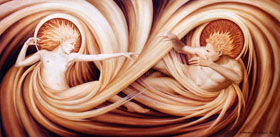 |
|
What
is Astrodharma?
 As
Eastern, non-dual teachings and practices continue
to infiltrate the West and our separation-affirming models of reality
crumble or harden into polarized, dogmatic factions, the oneness-affirming
truths of ancient oracular arts like astrology become more and more compelling. As
Eastern, non-dual teachings and practices continue
to infiltrate the West and our separation-affirming models of reality
crumble or harden into polarized, dogmatic factions, the oneness-affirming
truths of ancient oracular arts like astrology become more and more compelling.
 Even
the current rash of oversimplified and misleading sun sign columns is
a sign of spiritual opening insofar as they signal a growing demand for
unmediated, interpersonally verifiable truths that demonstrate we are
submerged in- and imprinted by- an Intelligence of cosmic dimensions. Even
the current rash of oversimplified and misleading sun sign columns is
a sign of spiritual opening insofar as they signal a growing demand for
unmediated, interpersonally verifiable truths that demonstrate we are
submerged in- and imprinted by- an Intelligence of cosmic dimensions.
The reason astrology is undergoing
such a renaissance is because it is so effective at seducing our otherwise
lonely, hard-edged egos to dissolve themselves—however briefly—into
bona-fide experiences of oneness. By appearing, at first, to be a mind-made
system of typing people, astrology presents to our egos the mouth-watering
possibility of better understanding— and, thereby, better seducing—
the minds of those it considers separate, desirable and good. At the same
time, it promises to equip us with the perceptual tools needed to avoid
and defend ourselves against the dangerous “bad” people. Is
this not the closest thing to heaven an eternally orphaned mind could
hope for?
However, as ego actually starts
peering at itself, others and the events of the world through astrology’s
symbolic lens, it quickly becomes exposed to energetic patterns and felt
meanings that are far too fluid and multi-dimensional to be captured and
pinned down by thought. Before we know it, we’ve developed an appetite
for intuitive insights that are only accessible to the extent that we
free ourselves from the very astrological dogma and preconceptions we
worked so hard to learn. From this perspective, cheap conversation starters
like “What’s your sign?” may actually be the collective
consciousness’ way of priming itself for the non-conceptual experiences
of dharma.
Dharma is a Sanskrit word meaning,
“the forces that hold the Universe together.” It refers to
a body of spiritual truths that so accurately articulate our soul’s
longing for (and our ego’s resistance to) embodied emptiness, or
Oneness, that they usher the self-inquiring mind to the cliff edge of
thought. If you’ve ever jumped from a frightening height, you know
that the person who finally decides to jump is not really “you.”
It is, rather, a feverish nobodyness that finally takes over. A nudge
of grace. This is dharma in action.
When this free-fall into the
experience of one Self is inspired by a body of astrological truths, I
call it “Astrodharma.” This perceptually alive (vs. “believed”)
form of astrology initiates us into a kind of extroverted mysticism. The
twelve archetypes—Aries through Pisces—appear, not so much
as personality attributes that divide us, but as “styles of awakening”
that underscore our common destiny. As we learn to identify and appreciate
these awakening styles in our self and others, our attention naturally
moves past their distracting, lower octave expressions to the luminous
intention that inspires them. Egos become less and less opaque. In this
way, we effectively free ourselves of reactivity to the veil of personality
and the burdens of the separate self.
To learn more about this dharmic
perspective on the twelve styles of awakening, click on the 12 Styles
of Awakening icon, or sign up for my free monthly Newsletter. |
|



